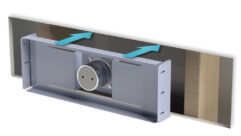Infocomm 2006
Although InfoComm has transitioned to an applications show, there were plenty of interesting product introductions.
InfoComm isn’t the “must attend” show it once was for unveiling cutting-edge, innovative display technologies. Even so, while the show’s focus is more on applications these days, there were still a few gems to be unearthed.
Ten years ago, you could always count on some big surprises at InfoComm. Whether it was the first portable single-chip DLP projector (nView’s Diamond D-455, $11,995), Sony’s first portable LCD projector (VPL-V500Q, $7,990), or high-power, large-venue SXGA projectors from AmPro, Barco, and Hughes-JVC, there was plenty of “oohing” and “aahing” to be heard in the old Shoot-Out.
Incidentally, those “high power” projectors from 1996 were rated at 2,500 lumens — a staggering amount of image brightness for the time — and their prices ranged from $62,000 to $85,000. Today, Dell’s 2400MP cranks out 3,000 lumens in a 5.5-pound box for $1,100. How times have changed.
The show has changed, too. Attendance is routinely more than 24,000, and there’s more of an end-user, applications focus than ever before.
Falling prices for former big-ticket AV products has had its impact on booth sizes. Gone for the most part are the monster booths that Sony, NEC, Hitachi, InFocus, and others used to assemble. A typical VGA (640×480) LCD front projector was priced between $7,000 and $10,000 dollars back in ’96; today, your garden-variety XGA box can be had for less than $2,000. With more products having three or four zeros in their price tags extensive re-branding and OEM deals, and the expansion of distribution channels and direct sales at the expense of the smaller pro AV dealers, many manufacturers just can’t justify the expense of a larger booth. Consequently, what we see are more “concept” booths with simulations of classrooms, conference rooms, and even home theaters, all featuring the company’s latest projectors and flat-panel displays.
Another change from the old days: The professional version of a product was introduced first, followed by a consumer version a year or so later. Today, the consumer market is all-important for display technology, and the timing is often reversed — we’ll see a large flat-panel plasma or LCD consumer HDTV before the commercial version is released.
While cruising the booths looking for unique and different products, I found that many products had already been shown at NAB 2006. Still, there were a few surprises. Epson, which had been noticeably absent from the show for several years, re-appeared in a modest booth with a new installation projector, the PowerLite 6100i. It’s a networkable XGA (1024×768) projector with 3,500 lumens of brightness, anti-theft bars, remote LAN monitoring, and an improved air filtration system. In addition, the PowerLite S4 is a bargain basement SVGA (800×600) LCD projector with 1,800 lumens for $699.
Hitachi’s ED10X XGA projector is a clever design — it incorporates custom full-color housings for color-coding to deter theft. It seems that a bunch of projectors were being removed from classrooms in England for viewing the World Cup, so the unique colors should identify where the projector was pilfered. Hitachi, Mitsubishi, and Epson also provide USB ports for playback of JPEG and MPEG files without a PC. Mitsubishi’s XD-435U ($2,495) is a representative sample of a single-chip DLP projector with XGA resolution, and it offers 2,500 lumens in addition to the USB interface.
Down the aisle, projectiondesign had several single-chip SXGA+ (1400×1050), 720p, and even 1080p DLP projectors out for inspection. The 6-pound EVO2 SX+ ($5,495, 2,500 lumens), 6.5-pound F1+ XGA ($6,499, 3,000 lumens) and Cineo3+ 080 (1920×1080, $24,495) all caught my eye.
Canon showed its commitment to SXGA+ with the 3,500-lumens REALiS SX6 and 2,500-lumens REALiS SX60. Both were previously shown at NAB. Optoma’s HD81 continued to tantalize; this single-chip, 1,200-lumens 1080p DLP design is still in the beta stage, but looked pretty darn good in demos.
Infocomm 2006
Although InfoComm has transitioned to an applications show, there were plenty of interesting product introductions.
The most intriguing 1080p front DLP projector wasn’t on the floor, but in a suite in the nearby Rosen Center hotel. Developed by Delta Electronics, it uses a 430 W Xenon lamp from Cermax and produced some beautiful colors, even if the demo material was a stretched 4:3 DVD.
Barco’s booth also contained several new presentation projectors. Among them were the iCon H600 (1920×1080, 6,000 lumens), which wasn’t necessarily a new model, but with 16:9 imaging perhaps somewhat enigmatic to many would-be customers. Nearby, the FLM R20+ chugged away, quietly producing 20,000 lumens with SXGA+ resolution and making some impressive images.
The flat panel world was busy, too. Sharp put the spotlight on its PN-655, a 65-inch 1920×1080 LCD industrial monitor that may be the largest available in any quantity (Samsung’s 80-inch product is still coming to market). Sharp also showed the LC-57D90U Aquos LCD HDTV. It’s a 1920×1080 model with bright, colorful images that will no doubt soon be offered as an industrial product for digital signage.
At the Samsung booth, its MagicNet LAN-operated scheduler and server with capacity up to 255 separate nodes (displays) was shown. Samsung also showed demos of LED and enhanced color cold-cathode fluorescent lamps (CCFLs); you may see them in the near future for smaller LCD monitors.
LG also had a slew of LCD and plasma monitors and TVs out for inspection, including several integrated HDTV sets. Its 55-inch LCD monitor was up and running, although it doesn’t seem to be shipping in any quantity at present. LG did unveil several TV/DTV interface boxes and plug-in cards, along with ProSelect head-end transcoders and modulators — all for a distributed RF signal system.
Panasonic had commercial versions of its 65-inch and 103-inch plasma monitors configured with tiled signal overlays for simulated command & control applications. This market has long been dominated by rear-projection cubes, but with the advent of larger PDP and LCD sizes, the tide could be shifting. Panasonic rounded out the package with a line of plug-in interface cards, something Sony also showed across the aisle for its line of LCD and plasma digital signage products.
I was surprised by the amount of LCD monitors in the Toshiba booth. The company appears to be quite serious about the digital signage market, offering seven different LCD screens ranging from 27 inches (P27LSA, 1366×768) to 56 inches (P56QHD, 3840×2160).
V Inc. didn’t exhibit at the show, but it didn’t matter. It stole a march on everyone by announcing a price reduction on its popular P50 HDM to $1,999 right before the show started — just in time for Father’s Day. In fact, Kramer Electronics promptly went out and bought one to demonstrate its VP-727 In-CTRL dual-channel seamless switcher/scaler product at InfoComm. It has eight RGBHV inputs and supports a wide range of scaled RGB and video resolutions, including 720p, 1080i, and 1080p.
Down the aisle, Analog Way unveiled a new multi-function TV-style switcher for its seamless switching products, including the OctoVue FX, which I saw at NAB 2006. Two other boxes caught my attention, including the Trident DVI (dual-channel one in, four out DVI distribution amplifier) and the Trident SDI/HD-SDI (also dual channel one in, four out DA). The output of one DA can be cascaded into the other for 1×7 operation.
The fact that the Large Venue Display Gallery, a remnant of the old Projection ShootOut, was hidden way in the back of the north end of the Orlando Convention Center shows that the focus of the show really has shifted from endless breakthroughs in projection and flat panel design to peddling mature, mass-market technologies and how to make them work in today’s AV environment.
Pete Putman is a contributing editor for Pro AV and president of ROAM Consulting, Doylestown, PA. Especially well known for the product testing/development services he provides manufacturers of projectors, monitors, integrated TVs, and display interfaces, he has also authored hundreds of technical articles, reviews, and columns for industry trade and consumer magazines over the last two decades. You can reach him at [email protected].










